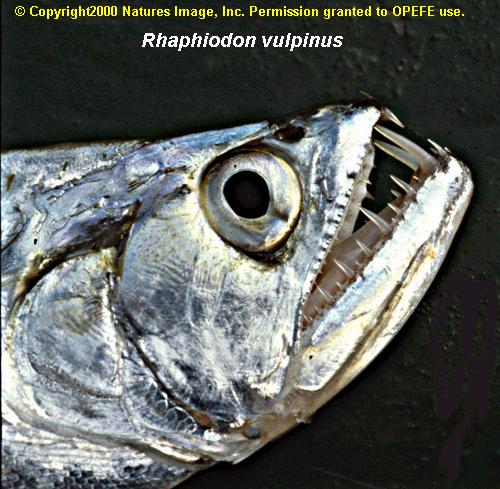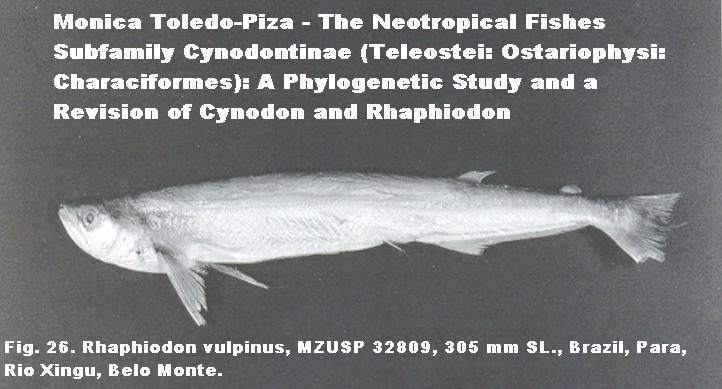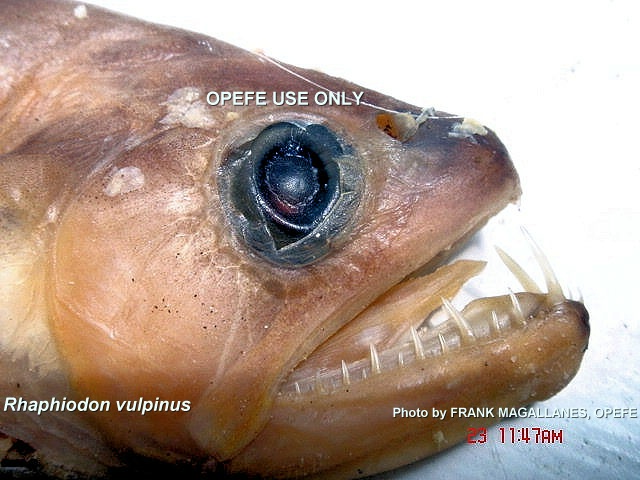Subfamily Cynodontinae
Genus Rhaphiodon vulpinus
Agassiz, 1829
Monotypic species
INTRODUCTION
Buckup and Petry (1994) examined extra-oral series of teeth in the larvae of genera Hydrolycus and Cynodon, a feature previously reported only for Rhaphiodon vulpinus (Géry and Pivre, 1979), and proposed this feature as a synapomorphy for the Cynodontinae. The presence of the 3 row of teeth in larvae and young juveniles is a synapomorphy for the family, since all 3 genera have it. Buckup and Petry did not find any evidence that Acestrorhynchus, Oligosarchus nor Cynopotamus have similar dentition transition from larvae to juvenile.
They named the dentition as follows:
1- Dentary inner ridge teeth, present in larvae and lost during ontogeny;
2- Dentary outter ridge teeth, present in larvae and maintained in adults,
3- Extra-oral teeth, hook-like teeth surrounding premaxilla and dentary, present on larvae and lost in larger juveniles.
The loss of the two series inner ridge and extra-oral teeth, seems to follow the same sequence in all 3 genera. This loss is the same for Hydrolycus and Rhaphiodon. Petry assembled entire transformation series, however, the work remains unpublished. During my visit with Paulo, I was afforded the opportunity to review the specimens and the laboratory work while at Oregon State University during this time frame.
The species was placed under numerous generic names by various authors;
Rhaphiodon vulpinus (Agassiz, 1829), Hydropardus rapax (Reinhardt, 1849), Cynodon vulpinus (Cuvier, 1829) Cuvier originally named the species as a Hydrocyon, Raphiodon vulpinus (genus name misspelled, Müller & Troschel, 1844), Cynodon vupinus (species name misspelled, Eigenmann, 1891), Rhaphiodon vulpinum (species name misspelled, Eigenmann and Allen, 1942), Rhaphiodontichthys vulpinus (listed in species of Venezuela, Campos, 1945), Rhaphiodontichthys vulpinus (genus name misspelled, Machado-Allison, 1987).
Rhaphiodon vulpinus is easily distinguished from other Cynodontinae by their long, stream-lined body and the placement of the dorsal fin on the posterior third of the body length. The dorsal fin placement also helps in identifying these species from Hydrolycus by the dorsal fin inserted slightly to the rear of the vertical through the anal fin origin.
The species R. vulpinus was originally described from a single specimen collected by Spix and Martius in the rivers from Brazil ("Brasiliae fluviis"). However the precise locality was not recorded by collectors. There seem to be a large degree of overlap in their meristic and morphometric characters studied (Toledo-Piza, 2000).
The species appears to be monotypic with their geographic distribution being; main rivers and their tributaries in the Amazon basin from the Rio Ucayali system in Peru, eastward to Rio Xingu in Brazil; lower to upper portions of Rio Orinoco basin; Rupununi River in the upper Essequibo River system in Guyana; Rio Paraná/Paraguay, and Uruguay basin, south to Rio de la Plata in Argentina.
The lack of additional collected specimens from some regions has been the basis for tentatively identifying them as R. vulpinus. Geographic variations of the species is found in the Rio Orinoco, Rio Amazonas, Rio Paraguay-Paraná, and Rio Uruguay sytems. Specimens collected from the Rio Negro seem to lack quinine for their color is a tan ground coloration on sides of body and head, dorsally slightly darker.
Rhaphiodon is the most widely distributed of the subfamily Cynodontinae in South America and the less speciose. Neither Hydrolycus or Cynodon occur south of the Amazon basin in the Rio Paraná/Paraquay and Rio Uruguay basins.
MAXIMUM SIZE
Maximum length reported to reach 64 cm SL
DISTRIBUTION
Amazon basin, Orinoco basin, Paraná basin (Paraná, Paraguay and Uruguay rivers), and rivers of Guyana.
Contributors and Advisors
-
Toledo-Piza, Mônica
-
Menezes, Naércio A
-
Petry, Paulo
REFERENCES
-
Toledo-Piza, Mônica, 2000, The Neotropical Fish Subfamily Cynodontinae (Teleostei: Ostariophysi: Characiformes): A Phylogenetic Study and a Revision of Cynodon and Rhaphiodon. Published by American Museum of Natural History, NY.
-
Toledo-Piza, M., Menezes, Naércio A., and Mendes dos Santos, G., 1999, Revision of the neotropical fish genus Hydrolycus (Ostariophysi: Cynodontinae) with the description of two new species. Published by Ichthyol. Explor. Freshwaters, Vol. 10, No. 3, pp. 255-280.
-
Géry, Jacques., 1977, Characoides of the World, pp. 299-302, TFH Publications, NJ.
USE YOUR BACKSPACE OR CLICK HERE TO RETURN OTHER PREDATORY FISHES
USE THIS LINK TO RETURN RESEARCH PAGE OR USE YOUR BACKSPACE
TO RETURN HOME CLICK HERE.
The OPEFE web site and its contents; is disclaimed for purposes of Zoological Nomenclature in accordance with the International Code of Zoological Nomenclature, Fourth Edition, Article 8.3 and 8.4. No new names or nomenclature changes are available from statements at this web site.
Copyright© 1994-2012 Oregon Piranha Exotic Fish Exhibit (The OPEFE fish exhibit is permanently CLOSED as of 2000) Sutherlin, Oregon. Information posted on this web site is archival data on fish scientific classifications and other information. DISCLAIMER: The copyrighted material may not be used for any purpose other than private study, scholarship or research. Cited information requires credit and this link www.opefe.com. All rights reserved. All images shown (unless otherwise noted) is property of OPEFE.
UPDATED: 12/27/2011





